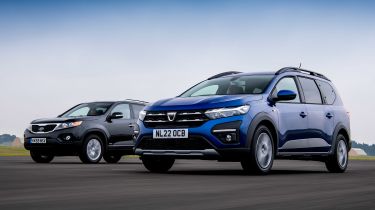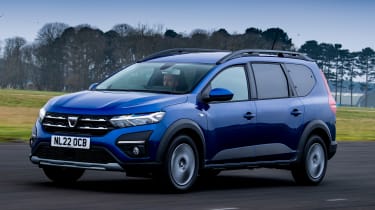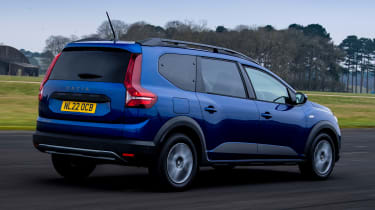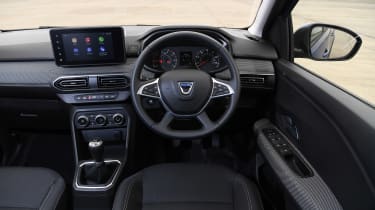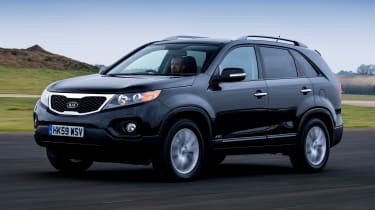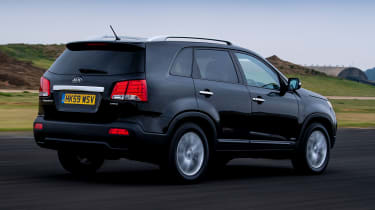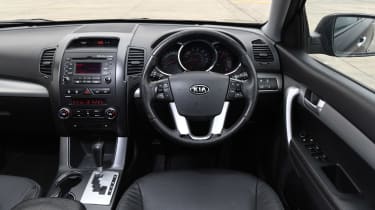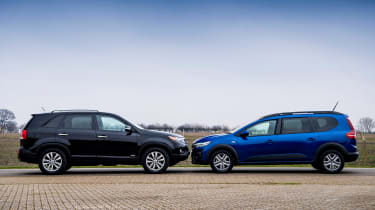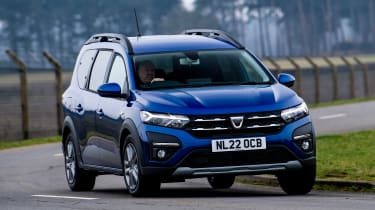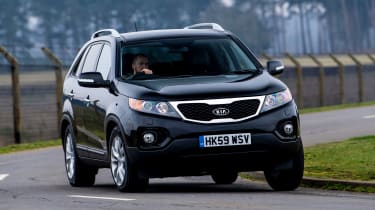New Dacia Jogger vs used Kia Sorento: 2022 twin test review
The Dacia Jogger sets new standards in the race to offer the most space per pound, but is it better than a second-hand Kia Sorento SUV?
Our first encounters with the new Dacia Jogger have been hugely positive. Each time we’ve climbed behind the wheel of the budget brand’s seven-seater, we’ve been impressed with a car that wraps up the practicality of an MPV and the load space of an estate into a pac`kage that barely takes up any more space than most
family hatchbacks. Yet it manages this while costing about as much as a typical city car.
It’s so cheap, in fact, that finding rivals on the new car market is very tricky. Most seven-seaters cost the wrong side of 30 grand, yet the Jogger starts from just under £15,000. Even potential estate car rivals cost significantly more, and the most affordable options rarely have anywhere near as much space inside.
So in reality, if you’re looking for a sensible, spacious car for £15,000-£18,000, the only viable alternatives are on the used market.
We’ve lined up one such vehicle here in the shape of the second-generation Kia Sorento – a car which in its day offered plenty of space and kit for the price. Later we’ll cover some other second-hand seven-seaters available at this price, because we really want to find out one thing: is there anything for the money that can compete with the Jogger? And are there any qualities that it misses out on that make heading down the used route a better bet?
New Dacia Jogger
| Model: | Dacia Jogger TCe 110 Comfort |
| Price: | £16,595 |
| Engine: | 1.0-litre 3cyl petrol, 108bhp |
| 0-62mph: | 11.2 seconds |
| Test economy: | 45.4mpg/10.0mpl |
| CO2: | 131g/km (WLTP) |
| Annual road tax: | £155 |
The new Dacia Jogger slots between the Sandero Stepway and Duster SUV in the firm’s line-up, and the most that you can spend on one – even with the only available add-ons of metallic paint (£595) and a spare wheel (£300) – is just £18,290. The car we have here is in mid-spec Comfort trim, which starts from £16,595, but has both of those extras for a total bill of £17,490.
Used - available now

2022 MG
HS
12,807 milesAutomaticPetrol1.5L
Cash £16,287
2021 Citroen
C1
11,182 milesManualPetrol1.0L
Cash £9,487
2017 Vauxhall
Insignia
96,309 milesManualDiesel1.6L
Cash £4,500
2019 Land Rover
Range Rover Evoque
94,100 milesManualDiesel2.0L
Cash £8,750Design & engineering
Dacia says that the Jogger is part-estate, part-SUV and part-MPV. Of those, it’s the SUV claim that’s the biggest stretch; sure, there’s some chunky body cladding for the wheelarches and a fake skidplate on the front bumper, but the Jogger doesn’t have the high-riding driving position of the Kia Sorento it takes on here.
With the other two claims, however, Dacia certainly has a point. The Jogger is based on similar CMF-B underpinnings as the Sandero and the Clio supermini from sister brand Renault. Up to the B-pillars it’s largely similar – both technically and aesthetically – to the Sandero too, but from there, the roof steps up 40mm and the wheelbase has been stretched by 459mm to 2,898mm. And every extra millimetre of the Jogger’s length has been maximised by a near-vertical back end.
That space is evident when you sit inside – as we’ll detail more in the practicality section. But from up front, you’d never be able to tell, because it feels much like a Sandero. There’s a logical cabin layout, with big rotary air-conditioning controls, and a strip of fabric trim on the dash to break up the hard plastics elsewhere. If you’re after a premium feel, this obviously isn’t the place to go, but the Dacia is simple and functional. It feels much more light and airy inside than the Kia, which also helps the sense of spaciousness, and that also means that all-round visibility is slightly better, too.
This is more than just a super-sized Sandero, though; design touches such as the modular roof bars, which unscrew and can be turned through 90 degrees to support up to 80kg of additional storage, prove that it’s also clever.
From launch, there’s just one engine to choose from. The 1.0-litre three cylinder turbocharged petrol makes 108bhp and 200Nm, while the only gearbox option is a six-speed manual.
Driving
One of the benefits of using underpinnings adapted from a supermini is that, unlike some seven-seat SUVs, the Jogger really doesn’t feel remotely intimidating or lethargic to drive. It’s light on its feet, manoeuvrable at low speeds, and overall feels closer in character to the supermini on which it’s based than the hefty vehicles that it’s trying to compete with.
That’s no surprise when you take a look at the scales; at 1,200kg, the Jogger is a full third lighter than the Sorento we have here.
Another benefit is that the fairly modest engine manages to move the Jogger along at a decent rate. It’s by no means fast, but there’s more than enough low-down torque to make it feel nippy around town, yet the Jogger is easily capable of sitting at a motorway cruise with plenty to spare – although the lower outright figures mean that it’s more likely to be pegged back than the more powerful Kia when fully loaded with seven people and luggage.
There’s not a huge amount of soundproofing – so engine noise is always present – but it’s quite a muted unit anyway, and doesn’t sound that harsh under acceleration. The only thing that harms refinement at higher speeds is the pronounced wind rustle from around the door mirrors.
Ownership
Being a brand-new car, the Jogger has a level of warranty cover that used rivals can’t compete with. There’s three years and 60,000 miles of protection from the moment you drive off the forecourt, while used competitors will get varying levels of cover, depending on whether you buy from a dealer or a private seller.
Running costs
Another benefit of the Jogger’s light weight/small engine combination is decent fuel economy. Our time with the car yielded a figure of 45.4mpg, which included a varied mix of town, A-road and motorway driving.
By contrast, the heavier Sorento averaged almost 10mpg less – and needs more expensive diesel, too. At today’s currently high prices, the Jogger would cost £3,308 in petrol every 20,000 miles, while the Sorento’s diesel would set you back £4,500 over the same period.
Dacia also offers a service plan with every new model, including the Jogger. It costs £399 for three years’ maintenance. Kia’s service plans run up to the sixth and seventh services at 60,000 and 70,000 miles; two services cost £319.
Testers’ notes: “For a car that wears its budget roots proudly on its sleeve, the fact that the Jogger gets cruise control as standard almost seems decadent.”
Used Kia Sorento
| Model: | Kia Sorento (2009-2014) 2.2 CRDi KX-2 |
| Price: | £17,000 |
| Engine: | 2.2-litre 4cyl diesel, 194bhp |
| 0-62mph: | 9.5 seconds |
| Test economy: | 35.8mpg/7.9mpl |
| CO2: | 175g/km (NEDC) |
| Annual road tax: | £250 |
The car in our pictures is part of Kia’s heritage fleet, and is an early version of the Sorento Mk2 with roughly 80,000 miles on the clock. For similar money to the Jogger, it’s possible to get a slightly newer car; we found a facelifted 2015 Sorento in KX-2 trim that had covered just 37,000 miles with an asking price of just under £17,000.
Design & engineering
Kia was undergoing a significant transformation in the early 2010s, turning itself from a brand that previously occupied a similar budget sector to Dacia today, and towards a manufacturer that can take on the best of the mainstream brands.
The Sorento was one of the key models in that transformation. It was among the first cars designed by Peter Schreyer – now Head of Design Management of Hyundai Motor Group – and was the first UK model to feature the ‘Tiger nose’ grille design that gave its models a more distinctive look.
The facelifted model differs from the car shown here with some cosmetic changes, but it also gained significant mechanical tweaks to improve comfort and refinement. It can be told apart from this car thanks to revised light clusters and bumpers front and rear. Subtle tweaks were introduced inside, too. There are no soft-touch plastics to be found in this example, but everything feels well built.
Steering wheel aside, this 80,000-mile car still looks and feels fresh, with few signs of wear, while the switchgear all operates in a pleasingly satisfying way that’s lacking in touchscreen-heavy modern vehicles.. The raised driving position gives a great view of the road ahead, and the leather seats are soft and comfortable. However, thick pillars – particularly at the rear – mean visibility isn’t great compared with the Jogger.
Elsewhere, the Sorento followed the conventional SUV formula of the time. As with the current car, it’s mechanically similar to the contemporary Hyundai Santa Fe, with both cars using the same 2.2-litre CRDi turbodiesel. It produces 194bhp and a hefty 436Nm, which arrives at just 1,800rpm. Manual and automatic gearboxes were offered, as was four-wheel drive – the latter feature setting it apart from its rival here.
Driving
From the moment you turn the key, you discover just how far not only SUVs have come in the space of a decade, but Kia as a brand, too. The diesel engine wakes into life with a loud, agricultural clatter, and it vibrates strongly through the cabin at idle.
On the move, the Sorento exhibits many of the trends you can expect from SUVs of this style and age. The steering is vague and slow, there’s lots of body roll in corners, and a generally ponderous feel. On the plus side, it’s fairly comfortable – even if knocks from the suspension over harsher bumps are quite noticeable. There’s also plenty of road noise from its larger tyres, which means it feels less refined overall than the Dacia.
The 2.2-litre diesel is noisy, but it feels strong. The hefty torque figure means that it pulls well pretty much from idle, and even when the car is loaded up with seven people and their kit, there’s not a significant drop-off in performance.
Ownership
The Sorento scored a five-star rating when it was assessed by safety body Euro NCAP. However, this was back in 2009, when testing standards weren’t as strict as they are today.
The Jogger hasn’t been tested by NCAP yet, but it lacks the level of driver-assistance tech that the current tests demand for it to achieve the highest ratings. However, equipment such as autonomous emergency braking and the blind-spot warning system that come as standard on the Jogger were very hard to come by when the Sorento was new.
Running costs
Back in 2015, the Sorento was tested to the NEDC emissions standard, rather than the current WLTP testing programme. As a result, it is rated against older road tax bands, and therefore the annual renewal costs are different to brand-new cars, too. The Kia’s official 175g/km figure means that you’ll need to pay £250 annually in Vehicle Excise Duty. From the second year onwards, the Jogger will cost £155.
Having taken the worst of its depreciation hit, the Sorento will lose value at a lower rate than the Jogger. Be sure to keep the Sorento well maintained – ideally at a main dealer if possible – and when the time comes to sell or trade in, you’ll give yourself the best possible chance of negotiating a strong value.
However, residual values are still excellent for the Jogger. After three years and 36,000 miles, it’s expected to be worth 60.41 per cent of its original price, which translates to a value of just over £10,000. The Extreme SE is slightly better still, at 61.66 per cent.
Testers’ notes: “The Sorento Mk2 has been the subject of two minor recalls, one in 2013, the other in 2017. It’s worth checking to see if the work has been carried out on any potential used purchase.”
Buying new vs used: what you need to consider
Traditionally, the key selling point of going for a second-hand car is that you tend to get more for your money than when you buy new. However, the Dacia Jogger is certainly trying to challenge that perception in the seven-seater class.
Choosing a used model such as the Sorento normally means that you have to accept certain pitfalls; the condition of the bodywork and interior will have been at the mercy of the previous owners, as will the mechanical condition of the car. That first downside will be immediately apparent on inspecting any vehicle – and if you’re not too concerned about aesthetics, then it might be a fairly decent point from which to start haggling on the asking price.
As for the quality of everything underneath, view the service book and ask for any receipts that provide evidence of previous maintenance. In the case of the Sorento Mk2, it needs a service every year or 20,000 miles, whichever comes first. From new, it had Kia’s industry-leading seven-year warranty, but that will have all but expired given the age of the used examples, so any significant faults could prove costly.
It’s also worth performing a vehicle history check. A number of companies offer to check a range of data (for a small fee) to establish whether or not the car has previously been involved in an accident, has been stolen, or is subject to any outstanding finance. Taking these steps before you buy might prevent a lot of headaches when you sell the vehicle on at a later date.
When it comes to the Sorento specifically, there are certain things that we recommend you look out for before buying. The leading edge of the roof can suffer from corrosion, and this is more likely if the windscreen has been replaced at some point. It’s great that a full-size spare is standard, but its location under the car means that an anti-theft device might be worth adding.
Perhaps crucially for some owners, the Kia’s diesel engine isn’t compliant with London’s Ultra Low Emission Zone. So if you travel anywhere within the North or South Circular roads, you’ll face charges of up to £12.50 a day. Other cities are considering or starting similar schemes as early as this year, including Bath, Birmingham, Portsmouth and Greater Manchester.
This once again highlights one of the key advantages of the Jogger. For the same money, you’re going to be the first owner to sit behind the wheel and make the most of Dacia’s (admittedly modest) three-year, 60,000-mile warranty, without the need to worry about whether or not the car is in a fit state to pass an MOT.
While there’s not much scope for personalising your Jogger, there is a choice of six colours; a no-cost gloss white option and a further five metallic shades that will set you back £595.
Verdict
First place: new Dacia Jogger
The Jogger has no direct rivals in the new-car ranks, and used rivals struggle to match it in many key areas, too. It holds its own against larger SUVs for cabin space, and the frugal engine, low finance payments and competitive service rates make it incredibly cheap to run. Factor in the peace of mind that comes from buying a new car, and for what you get for the cash, it’s incredibly hard to fault.
Second place: used Kia Sorento
Even as a seven-year-old vehicle, the Kia has its advantages, key among them that CRDi diesel, which makes it the perfect tow car. Loaded with seven people, it drives fine, too. It’ll need more maintenance than the Jogger, but at least Kia’s dealer network is excellent. However, the Jogger is better to drive, and has the added benefit of excellent warranty cover and low running costs.
Is it worth waiting for this model?
Dacia Jogger Hybrid
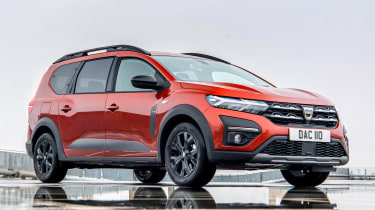
- Due: 2023
- Price: £21,000 (est)
- Engine: 1.6-litre 4cyl, 2x e-motors
The standard Jogger is light on fuel, but further savings are promised with the introduction of a hybrid powertrain, due next year. It’s more powerful, too, and the electric assistance and automatic gearbox should make it a smoother drive.
Figures
| Dacia Jogger TCe 110 Comfort | Kia Sorento (2009-2014) 2.2 CRDi KX-2 | |
| On the road price/total as tested | £16,595/£17,490 | £17,000/£17,000 |
| Residual value (after 3yrs/36,000) | £10,025/60.4% | N/A |
| Depreciation | £6,570 | N/A |
| Annual tax liability std/higher rate | £915/£1,830 | £2,261/£4,522 |
| Annual fuel cost (12k/20k miles) | £1,985/£3,308 | £2,700/£4,500 |
| Insurance group/quote/VED | 13/£362/£155 | 21/£576/£250 |
| Cost of 1st/2nd/3rd service | £399 (3 years) | £319 (2 years) |
| Length/wheelbase | 4,547/2,898mm | 4,685/2,700mm |
| Height/width | 1,691/1,848mm | 1,735/1,885mm |
| Engine | 3cyl in turbo/999cc | 4cyl in/2,199cc |
| Peak power/revs | 108/5,000 bhp/rpm | 194/3,800 bhp/rpm |
| Peak torque/revs | 200/2,900 Nm/rpm | 436,1,800 Nm/rpm |
| Transmission | 6-spd man/fwd | 6-spd auto/4WD |
| Fuel tank capacity/spare wheel | 50 litres/£300 | 64 litres/yes |
| Boot capacity (7/5/2-seat modes) | 160/565/2,085 litres | 116/515/1,530 litres |
| Kerbweight/payload/towing weight | 1,205/657/1,200kg | 1,919/591/2,000kg |
| Turning circle | 11.7 metres | 10.9 metres |
| Basic warranty (miles)/recovery | 3 yrs (60,000)/3 yrs | 7yrs (100,000)/1yr |
| Driver Power manufacturer/dealer pos | 27th/N/A | 2nd/3rd |
| NCAP: Adult/child/ped./assist/stars | N/A | 87/84/44/71/5 (’09) |
| 0-62mph/top speed | 11.2 secs/114mph | 9.5 secs/118mph |
| Auto Express econ (mpg/mpl)/range | 45.4/10.0/499 miles | 35.8/7.9/504 miles |
| Combined economy | 47.1mpg (WLTP) | 42.2mpg (NEDC) |
| Combined economy | 10.0mpl (WLTP) | 9.3mpl (NEDC) |
| Actual/claimed CO2/tax bracket | 144/131g/km/31% | 211/175g/km*/37% |
| Airbags/Isofix | Yes/yes | Yes/yes |
| Parking sensors/rear camera | Front & rear/yes | Rear/no |
| Auto gearbox/lane-keep assist | No/no | Yes/no |
| Blind-spot warning/AEB | Yes/yes | No/no |
| Climate control/cruise control | Yes/yes | Yes/yes |
| Leather/heated seats | No/no | Yes/yes |
| Metallic paint/LED headlights | £595/yes | Option/xenon |
| Keyless entry & go/power tailgate | Yes/no | No/no |
| Sat-nav/digital dashboard | No/no | Yes/no |
| DAB radio/connected services | Yes/yes | No/no |
| Wireless charge/CarPlay/Android Auto | No/yes/yes | No/no/no |
